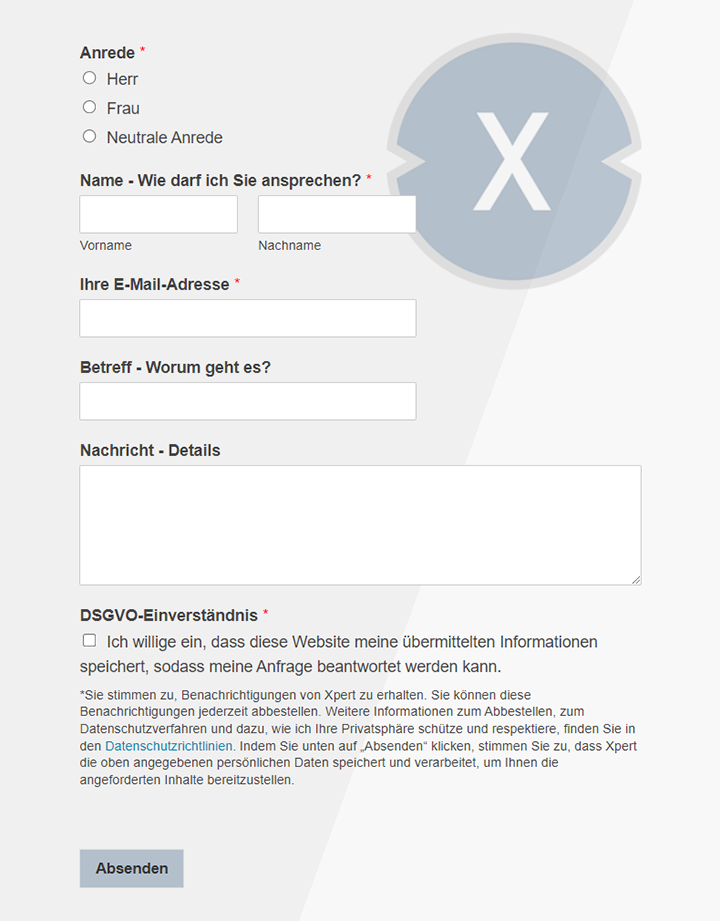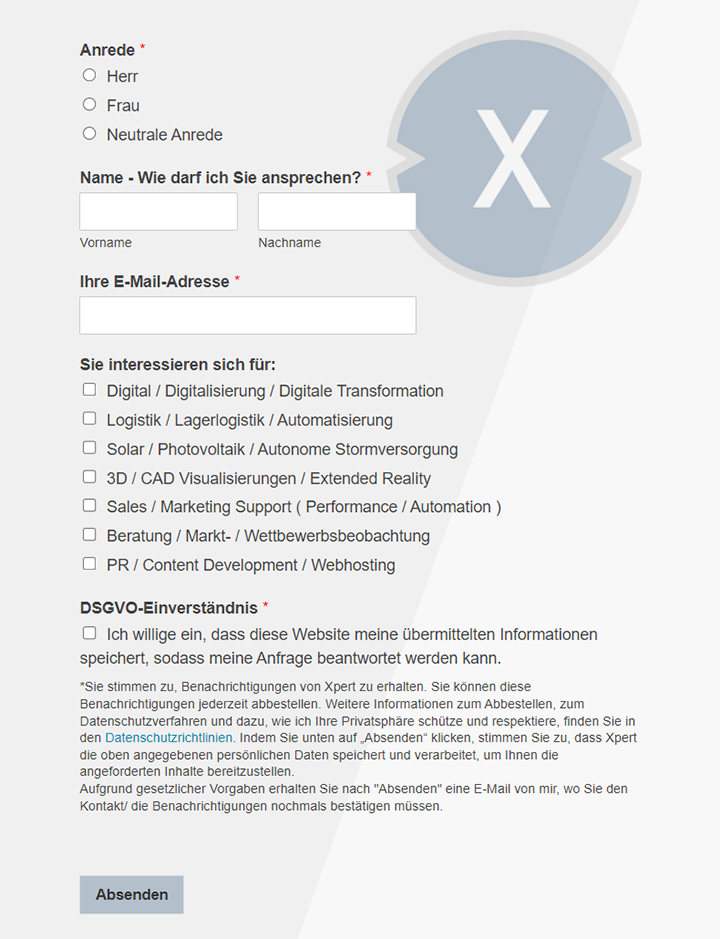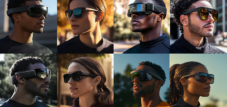Xpert study on “The Market for Smart Glasses” - Analysis of market penetration, competition and future trends
Xpert pre-release
Language selection 📢
Published on: April 16, 2025 / update from: April 16, 2025 - Author: Konrad Wolfenstein

Xpert study on “The market for smart glasses” - analysis of market penetration, competition and future trends - Image: Xpert.digital
Smart Glasses in the upswing: How Ki revolutionizes the industry (reading time: 37 min / no advertising / no paywall)
Growth and competition: the billion dollar market for intelligent glasses
The global market for smart glasses is currently experiencing a remarkable Renaissance, driven by significant progress in artificial intelligence (AI) and the successful market launch of products such as the Ray-Ban Meta Smart Glasses. After a phase of disillusionment, which followed initial hypes, the market now again records impressive growth rates, with forecasts that indicate a continuously high dynamic. Estimates for the annual growth rate (CAGR) range from around 27 % to over 60 % for the coming years, which suggests considerable market potential. This development attracts a large number of new competitors, which leads to an intensification of the competition, which is described as a “struggle of hundreds of smart glasses”. The market is increasingly differentiated into two main segments: on the one hand, consumer-oriented AI glasses that rely on style, basic assistance functions and media integration, led by META. On the other hand, more technologically demanding augmented reality (AR) and Extended Reality (XR) devices that aim at immersive experiences, productivity and specialized corporate applications, with actors such as Apple, Microsoft, Vuzix and XReal. Despite the optimism, there are fundamental challenges, in particular in terms of costs, battery life, design and comfort as well as the critical aspects of data protection and social acceptance. The further development of key technologies such as displays, processors, batteries and software platforms, in particular the integration of AI, will be crucial for overcoming these hurdles and the implementation of the full market potential.
Suitable for:
The revival of the Smart Glasses market
This report analyzes the global market for Smart Glasses, which includes a wide range of devices - from simple glasses with information display to completely immersive augmented reality (AR) and Extended Reality (XR). Key players, technologies, applications, market trends, challenges and future prospects are examined.
After initial hype and subsequent disillusionment, symbolized by failing products such as Google Glass in the consumer market, the market for Smart Glasses is currently experiencing significant revival. Global deliveries recorded impressive growth of 156 % in 2023 and estimated 210 % in 2024 compared to the previous year. For the first time, the brand was exceeded by two million units, which marked an unprecedented pace of growth. This growth is largely powered by the success of AI-integrated consumer devices.
The primary catalyst for this upswing is the integration of artificial intelligence (AI), which transforms smart glasses from passive display devices into interactive and useful assistants. The success of specific products such as the Ray-Ban Meta Smart Glasses has validated the concept of AI consumption glasses and boosted demand. At the same time, ripening component technologies (displays, chips, batteries) and developing software platforms form the necessary technological basis. A growing interest in AR- and Mixed Reality (MR) applications in both corporate and consumer sector also drives demand.
However, the current market dynamics indicate more than just a simple growth; It represents a redefinition of the market. Earlier smart glasses generations failed, among other things, due to the lack of convincing applications beyond notifications and social bias due to chunky designs and data protection concerns. The new wave, led by AI-supported functions such as voice assistant, context-related information and real-time translation, integrated into fashionable designs such as the Ray-Ban meta-glasses, addresses these previous vulnerabilities directly. This suggests that the current growth phase could be more sustainable because it builds on the teachings from past failures and overcomes fundamental adoption barriers.
Technology understanding: concepts, components and trends
Differentiation of the devices
The term “smart glasses” includes a growing variety of devices with different skills and objectives. Three main categories can be distinguished for better classification, with the borders increasingly blurring.
Pure “Smart Glasses”
Concept: These devices concentrate on displaying information discreetly in the user's field of vision (e.g. notifications, navigation instructions, fitness data) and fundamental connectivity and media functions. They often resemble traditional glasses and act primarily as companions for smartphones.
Main features: information display, Bluetooth/WLAN connectivity, basic sensors (accelerometer), hands-free language control, partly cameras for simple recordings. Examples could be early versions of Google Glass or current glasses that are focused on audio and notifications such as the solos Airgo 3 or Xiaomi Mijia Smart Audio Glasses that do not offer significant AR overlays.
Target group: everyday users who are looking for comfortable access to information, free -handed communication and basic assistance functions.
Augmented Reality (AR) glasses
Concept: AR glasses go beyond the pure information indicator by overlapping the real world directly and interactively with digital content. They merge virtual elements with the physical environment and destinations on spatial understanding and interaction.
Main features: AR overlays (overlays), interactive virtual elements, 3D presentation, spatial understanding (using cameras/sensors such as DOF-tracking), context-related information. Examples are Microsoft Hololens, Magic Leap, VuziX Blade/M400 (with a focus on companies) and Xreal Air/One (with a focus on consumers).
Target group: specialists in industry (assembly, maintenance), medicine (surgery, diagnosis), education (interactive learning), gaming and entertainment (immersive experiences), retail (virtual fitting) as well as for remote maintenance and developer.
Extended reality (XR) glasses
Concept: XR is an umbrella term that includes AR, Virtual Reality (VR) and Mixed Reality (MR). XR devices aim to enable experiences across this entire spectrum by possibly switching or mixing them between different modes. MR is often realized by Passhrough video, in which the real environment is captured by cameras and combined with virtual elements on the display.
Main features: ability to do AR-overlays and/or completely immersive VR, often use of Passhrough cameras for MR, advanced spatial tracking (e.g. 6dof), hand tracking. Examples are META Quest 3 (primarily VR, but with strong MR skills), Apple Vision Pro (high-end MR/Spatial Computing) and potentially future high-end devices from Samsung/Google.
Target group: broad potential, from players and entertainment consumers to experts who need a variety of tools for simulation, collaboration and visualization.
Comparative analysis of smart, AR and XR glasses concepts
The comparative analysis of the different glasses concepts in the area of intelligent wearables shows three essential categories with different areas of application and target groups. Smart Glasses primarily act as discrete information equipment and smartphone companions in a glasses-like design. They offer functions such as notifications, navigation, audio and voice control, sometimes also with a simple camera. These devices are aimed at everyday users and certain professional groups that need quick access to information. Well-known examples of this are the Ray-Ban Meta with AI focus, the Solos Airgo 3 for audio and fitness, the Xiaomi Mijia Audio and the early Google Glass.
AR glasses, on the other hand, overlap interactive digital content to the real world with a spatial context. Their main features include AR-overlays, 3D representation, spatial tracking and context-sensitive information, whereby they often offer a transparent view. This technology is particularly used in industry for maintenance and training, medicine, design, gaming and remote maintenance. The target group consists of specialists, developers, gamers and technology enthusiasts. The representative examples include Microsoft Hololens, VuziX M400/Blade, Magic Leap as well as Xreal Air/One and Asus Airvision M1 as display solutions.
XR glasses (Mixed Reality/Virtual Reality) form the most comprehensive category and associations AR and VR technologies, often with PASSHROUGH video for mixed reality experiences that are particularly immersive. They are characterized by AR/VR capabilities, passenthrough MR, advanced spatial tracking and hand tracking and often have a headset form factor. Your areas of application include immersive gaming and entertainment, simulation, training, collaboration and virtual desktops. Gamers, entertainment consumers, specialists in the area of simulation and design as well as early adopters are addressed as the target group. The Meta Quest 3, Apple Vision Pro and upcoming Samsung/Google Headsets are to be mentioned here as representative examples.
The category “XR” not only represents a device type, but rather a technological direction of development towards the integration of different levels of reality. Devices such as the Meta Quest 3 and Apple Vision Pro move the borders and indicate that future devices may no longer be clearly classified in “AR” or “VR”. Instead, they will offer a fluent spectrum of experiences, enabled through advanced passenthrough technology and highly developed software platforms. This convergence complicates a simple categorization, but indicates a future with more versatile hardware, which dissolves from rigid AR/VR definitions and becomes a uniform, flexible platform for digital interaction.
Important basic technologies and innovations
The progress in the smart glasses market is significantly promoted by innovations in key technologies.
1. Display technologies
The display technology is crucial for the user experience. Progress focuses on brightness, resolution, field of vision (Field of View, FOV), energy efficiency and form factor (transparency, weight). The key technologies include:
- Micro-Oled: This technology is often used in current Consumer-Ar glasses such as Xreal Air/One and Viture Pro. It offers high resolution and contrasts with a compact size. The brightness is an important factor for use outdoors; Viture Pro claims top values of 4000 nits (1000 nits perceived), while Xreal One reaches 600 nits. The FOV influences the immersion, whereby current models reaching values around 46 ° (Viture Pro) up to 50 ° (XReal One).
- LCOS (Liquid Crystal on Silicon): For example, is used in the VUZIX Ultralite Pro OEM platform and enables colored 3D-AR experiences.
- Microled: is considered a promising future technology with potential for high brightness and efficiency, but still faces challenges in mass production and yield. VuziX uses monochrome microleds in its ultra-lite audio OEM platform for longer battery life.
- Waveguides (light guide): These optical components are essential to project the image of a microdisplay source compactly and transparently in front of the user's eye. Developments aim at greater efficiency, lower thickness (vuziX shows 1.0 mm thin wave conductor) and the enabling of full color with wider FOV. There are different types, such as reflective wave conductors, with Letinar relating to cost -effective plastic variants. Integration with AI to optimize energy efficiency is a research field. VuziX also emphasizes its “Incognito” technology for discrete displays.
- Electrochromic Dimming: Technologies to adapt the lens tinting, as used in Viture Pro and Xreal Air 2 Pro, increase the versatility in different lighting conditions.
The choice of display technology significantly determines the primary application and the form factor of the device. High-resolution micro-oleds with a moderate FOV, as they are installed in XReal and Viture glasses, are well suited as portable monitors for media consumption and gaming-they offer an AR-like display, but no complete overlay of the real world. More complex systems with wave ladders and projectors, such as those used in Hololens or potentially the VuziX Ultralite Pro, enable real AR-overlays, but often lead to chunkier or more expensive designs. The trend towards thinner wave ladders and more efficient microdisplays is therefore crucial to realize consumer-friendly AR glasses. This technological choice is fundamentally segmented the current skills and target applications in the market.
Suitable for:
- Advancement in XR technology for the Metaverse, AR and VR glasses: full-color laser for 4K smartglasses from TDK
2. The role of artificial intelligence (AI)
Ki transforms Smart Glasses from passive display devices to interactive, intelligent assistants and is the main driver behind the latest market swing. AI functions include:
- Natural Language Processing (NLP): enables intuitive voice control, understanding complex commands and free -handed operation. Examples are META AI (“Hey Meta”), Chatgpt integration in Solos Airgo 3 and the planned integration of Google Gemini.
- Computer Vision: Allow the glasses to “see” and understand the surroundings. This enables object recognition, real-time translation, the provision of context-related information as well as precise AR tracking and spatial understanding. ON-DEVICE processing (directly on the glasses) is gaining in importance, as with rokid glasses.
- Proactive & context -related assistance: AI analyzes sensor data, location and user behavior in order to offer timely, relevant information without explicit request.
- Multimodal AI: combines different AI models (e.g. noise recognition + object recognition + calorie estimate) for complex applications.
AI integration takes place directly on the device (which requires efficient processors with NPUs) and via the connection to smartphones or the cloud. AI is considered fundamental for the future of XR. Generative AI also plays a role in improving realism in AR and represents a huge market.
AI is not just another feature, but also develops into a core promise of value in the segment of the Consumer Smart Glasses. It differentiates these devices from simple wearables and possibly paving the way that they become primary interaction for interaction with AI assistants, which could challenge smartphones in certain contexts. The competition is increasingly shifting from pure hardware specifications to the intelligence of glasses and the integrated user experience. Linking the AI-driven growth with the detailed AI functions and the discussion about the potential as a smartphone replacement underlines this strategic shift.
3. Computing power and chip sets
Powerful, yet energy-efficient processors are required to cope with AI tasks, sensorus and graphics rendering, especially for AR/XR. Qualcomm is a key player with his specially developed Snapdragon XR platforms (XR1, XR2, XR2+ Gen 2, AR1 Gen 1). These chips integrate CPUs, GPUs and NPUs (Neural Processing Units) for AI tasks. Companies such as Google (tensor) and potentially Apple rely on their own chips. XReal uses its own X1 chip for spatial computing functions. The balance between power, power consumption and heat discharge in a small form factor is a major challenge.
4. Accounting and energy efficiency
The battery life remains one of the greatest challenges. Current devices often only offer a few hours of active use time (e.g. Ray-Ban Meta approx. 4 hours; on 5 hours; solos Airgo 3 up to 11 hours, but only audio). The use of features, especially the camera, has a strong influence on consumption. Improvements result from more efficient components (chips, displays), better power management in software and advances in battery technology (higher energy density, smaller design). Charging cases are standard to extend usability. Energy efficiency is also a sales argument for intelligent glass in construction that uses related technologies such as electrochromy, which underlines the cross -sector focus on energy savings.
The battery life acts as a fundamental restriction for functionality and acceptance. The compromise between features (in particular display brightness/complexity, continuous sensor recording, AI processing) and duration dictates the device design and the application cases. Reaching a “all -day” battery life is a critical milestone so that smart glasses can grow beyond niche applications or short usage intervals and become really integrated everyday companions. This restriction drives innovations in power -saving components and optimized software, as the numerous mentions show as a challenge and efforts to increase efficiency.
5. Connectivity
Connectivity is essential for access to data, cloud AI and the interaction with other devices. Standard technologies are Bluetooth (for smartphone coupling, audio) and WLAN. The introduction of 5G is seen as a significant opportunity, since it offers high speeds and low latency times that are decisive for demanding AR/XR experiences and the outsourcing of computing power to the EDGE/cloud. A seamless and robust connection in a compact form factor remains a technical challenge. WLAN dominates in industrial applications that require high bandwidths.
6. Software platforms & ecosystems
Special operating systems for XR are established. Google has announced Android XR and works with partners such as Samsung, Qualcomm, Sony, Lynx and Xreal to create a wide platform for different device types. The aim is to provide the operating system, APIs and AI bases. Meta uses its own platform (probably Android-based) for quest headsets and Ray-Ban glasses, integrated with the Meta View app. Apple relies on visionos for the Vision Pro. Qualcomm offers the Snapdragon Spaces XR Developer platform for application development. Developer SDKs (Meta SDK, Lens Studio, Xreal NRSDK, Rokid SDK) are crucial for the creation of applications and content. The availability of convincing apps and content is a key factor for acceptance.
The Smart Glasses Markt enters a phase of the platform competition, similar to the struggle of smartphone operating systems (iOS vs. Android). Google's Android XR strategy aims to create an open ecosystem in order to counter Apple's closed visionos and metas established platform. The success of these platforms will depend heavily on attracting developers and enabling seamless experiences over the hardware of different manufacturers. The choice of a platform by OEMS, such as Samsung's decision for Android XR, is a significant strategic course.
Technological trends and developments in Smart Glasses
Several significant development trends are currently emerging in the area of smart glass technology. In the display technologies, micro-oled solutions for consumer-ar displays dominate, while at the same time working on the optimization of wave ladders in terms of thickness and efficiency. Microled is considered a promising future technology. This progress leads to improved image quality, higher brightness and increased efficiency, which enables slimmer device constructions - but with certain compromises in the field of vision and costs.
The AI integration develops into a central element of modern smart glasses. Inspectioning implementations of Natural Language Processing and Computer Vision, combined with on-device and cloud processing as well as multimodal models, transform these devices into intelligent assistants. This opens up innovative applications such as real-time translations and context-related information provision.
In the area of processors, manufacturers are increasingly relying on specialized XR/AR chips, such as Snapdragon XR/AR, with integrated neural processing units and tailor-made silicon. These technologies enable complex AR and AI calculations with reduced electricity consumption and lower heat development at the same time.
Battery technology remains a critical hurdle for the broad acceptance of Smart Glasses. The focus here is on improved energy efficiency in both hardware components as well as software, higher energy density and innovative solutions such as charging envelopes. Nevertheless, further progress is necessary to enable full -day use.
In connectivity, Bluetooth and WLAN form the current standard, while 5G is considered promising technology for low latency times and cloud-xR applications. These connection technologies are crucial for seamless data access and cloud functionalities, whereby 5G has the potential to significantly improve immersive experiences.
Dedicated XR operating systems such as Android XR and Visionos as well as developer platforms such as Snapdragon Spaces develop on the software side. These systems are essential for the structure of functioning ecosystems to attract developers and enable cross -platform experiences.
🎯🎯🎯 Benefit from Xpert.Digital's extensive, fivefold expertise in a comprehensive service package | R&D, XR, PR & SEM

AI & XR 3D Rendering Machine: Fivefold expertise from Xpert.Digital in a comprehensive service package, R&D XR, PR & SEM - Image: Xpert.Digital
Xpert.Digital has in-depth knowledge of various industries. This allows us to develop tailor-made strategies that are tailored precisely to the requirements and challenges of your specific market segment. By continually analyzing market trends and following industry developments, we can act with foresight and offer innovative solutions. Through the combination of experience and knowledge, we generate added value and give our customers a decisive competitive advantage.
More about it here:
Smart Glasses/AR/VR market: The greatest growth opportunities by 2030
Market analysis: size, growth and forecasts
The evaluation of the global market size for Smart Glasses is complex, since the definitions and the scope of the analyzed segments vary greatly between various market research companies.
Market size
Estimates for the pure Smart Glasses market in 2024 ranges from USD $ 1.93 billion (Grandview Research) to 5.98 billion (Cognitive Market Research). These discrepancies are likely to be attributed to different definitions which device types (from audio glasses to simple AR glasses) are trapped. Grandview Research forecast a value of $ 2.47 billion for 2025. Technavio expects an increase of $ 90.6 million between 2024 and 2029. Forecasts for 2030 are USD 4.13 billion (marketing margins) and $ 8.26 billion (Grandview Research).
The broader market for AR/VR Smart Glasses was estimated at $ 16.6 billion in 2023 and $ 45.6 billion (Straits Research) in 2024. Forecasts for the future range from $ 41.6 billion by 2029 (The Business Research Company) to $ 47.9 billion to 2032 to $ 120.87 billion to 2033 (Straits Research).
It is important to distinguish this from the market for intelligent glass (for architecture and automotive), which will be estimated to be $ 6.42 billion in 2025 and should grow to USD 10.42 billion by 2030. Market Research Future estimated this market for USD 6.5 billion with a forecast of $ 16.10 billion by 2030.
The overarching market for Wearable Technology was $ 70 billion in 2023 and is expected to increase to $ 94 billion and $ 231 billion by 2032 by 2025. The IoT market (Internet of Things) is in the area of hundreds of billions of dollars, and the generative AI market will be forecast to USD 1.3 trillion by 2032.
Suitable for:
- From AR to AI - everything that doesn't already exist: intelligent glasses, smart glasses, AI glasses, AR glasses, VR glasses, MR glasses and XR glasses
Growth rates (CAGR)
The forecasts for annual growth are consistently high, but also vary greatly. For Smart Glasses, the CAGR estimates are between 14.5 % (TechnaVio, 2024-2029) and 29.4 % (market sand markets, 2024-2030), with cognitive market research 27.5 % (2024-2031) and GrandViewresearch specify 27.3 % (2025-2030). Counterpoint Research predicts, driven by the success of the Ray-Ban Meta, even a CAGR of over 60 % until 2029.
For the AR/VR Smart Glasses market, the CAGR forecasts are 11.44 % (Straits Research, 2025-2033), 12.5 % (2023-2032) and 18.0 % (until 2029). IDC predicts a CAGR of 89 % (2022-2027) for the AR market alone.
The market for intelligent glass (architecture) is to grow with a CAGR of 10.2 % (market sand markets, 2025-2030) or 13.84 % (Market Research Future, 2024-2030).
segmentation
The market is segmented according to various criteria:
- Device type: Monocular vs. Binocular; Basic vs. Extended functions. Binocular glasses are expected to hold a prominent share. Models with extended functions (audio, camera, sensors) are expected to achieve the largest share by 2030.
- Technology: AR, VR, Mr. AR glasses are currently leading the AR/VR glasses market.
- Connectivity: WLAN, Bluetooth, mobile radio. WLAN dominates in industrial environments.
- Application: Consumers vs. Companies (healthcare, industry, gaming, logistics etc.). The consumer goods industry is expected as an important growth driver, although corporate applications, especially in the AR area, make up a large part.
Regional analysis
- North America: Currently dominates the market share (33.8 % for wearables; 35.4 % in industrial smart glass 2025; over 40 % for AR/VR glasses). This is due to the strong presence of key players (Meta, Google, Apple, Microsoft, VuziX), high technology acceptance and beneficial framework conditions. Lucrative growth opportunities are expected.
- Asia-Pacific: expects the fastest growth. CAGR estimates are 29.5 % (Smart Glasses, 2024-2031) and 14 % (Smart Glass-Architecture, 2021-2026). Drivers are the strong production base (China, India, South Korea), large consumer markets, the presence of manufacturers (Xiaomi, Huawei, TCL, Samsung, Japanese companies) and lower manufacturing costs. A CAGR of 104 % is forecast for the Chinese AR market. In Japan, 415,000 XR units were expected to be delivered in 2023.
- Europe: holds a significant market share (25.4 % in wearables). Growth is driven by technological progress, the demand for energy -efficient products (drives the adaptation of Smart Glass) and potentially by regulatory framework (e.g. EU AI Act). Great Britain holds 9 % on the global market for immersive reality.
The significant spread of estimates for market size and CAGR illustrates the lack of a standardized market definition and a significant uncertainty. The term “Smart Glasses” can include everything from audio glasses to full MR headsets. This ambiguity complicates direct comparisons, but underlines the young and fragmented nature of the market. The extremely high CAGR forecasts of some sources (such as Counterpoints 60%+) are probably strongly influenced by the currently low basis and the expected influence of AI glasses. This indicates a potentially volatile growth rather than a steady, predictable expansion.
Competition dynamics and strategies of the main actors
General competitive landscape
The market for Smart Glasses is becoming increasingly confusing and more competitive. Driven by the success of the Ray-Ban Meta and the perceived potential of the AI integration, numerous new players are pushing on the market. The forecast for 2025 is “fight hundreds of smart glasses”. The competition takes place in various segments: consumer-ki glasses, consumer-ar-glasses (often used as portable displays), enterprise-ar/MR solutions and high-end-xr headsets. The main players include established technologies, specialized AR/VR companies as well as numerous new market participants, especially from China.
Market share analysis
Meta developed a dominant position, especially after the introduction of the Ray-Ban Meta, and in 2024 held over 60 % of the global market share at Smart Glasses. In the wider VR/AR headset market (sales share Q4 2022), Meta was 81 %, far ahead of DPVR and PICO with 7 % each (this data is older and VR focus).
In the specific segment of AR glasses, Xreal takes a leading position with a market share of 47.3 % in the first half of 2024. Earlier data for Q3 2023 showed 51 %. Another source, which focuses on the Chinese AR market (probably older data), saw NRAAL (XReal) with 34.5 % first, followed by Thunderbird (Rayneo/TCL) with 28.6 %, Rokid with 24.4 % and Xiaomi with 8.5 %. In the broader wearable market, actors such as Sony, Apple, Huawei, Adidas, Nike, Alphabet, Samsung and Xiaomi compete.
Estimated market share of leading smart/AR glasses providers
The landscape of the smart and AR glasses providers is currently showing clear market leaders. With over 60%, Meta dominates the overall market of the smart glasses in the consumer segment according to data from 2024, which is largely due to the success of the Ray Ban Meta models. In the specific AR glasses segment, Xreal has a leading position, with a global market share of 47.3% in the first half of 2024 and even 51% in the third quarter of 2023. In the Chinese market for AR glasses, Xreal holds a share of 34.5%, followed by Rayneo (under the company Thunderbird Innovation) with 28.6% and Rokid with 24.4%, although The latter company serves both consumer and corporate customers. Xiaomi completes the list of important providers in China with a market share of 8.5% in the AR/audio glasses segment. The exact periods for the Chinese market data could not be specified in the sources of us.
The currently most important Smart/AR glasses manufacturers
1. Meta
- Strategy: leads the market for consumer AI glasses through the partnership with essilorluxottica (Ray-Ban, Oakley). The focus is on fashionable design, camera/audio functions and integrated META AI assistant. Plans aggressive expansion from 2025, probably by expanding the product portfolio. Develops advanced AR glasses (Orion prototype), but faces cost challenges. Dominant player in the VR area with the quest line.
- Products: Ray-Ban Meta Smart Glasses (Wayfarer, Skyler Styles), Meta Quest VR/MR Headsets.
- Strengths: Strong brand partnership (Ray-Ban), leading AI integration, established ecosystem (meta-platform, social media integration), market leadership and momentum, strong financial resources (although reality labs is under pressure).
- Weaknesses: Data protection concerns in connection with META, limited AR capabilities of current glasses, potential battery life restrictions, high costs for advanced AR development (Orion).
2. Google
- Strategy: Currently focuses on providing the software platform (Android XR) and KI (Gemini) for partners (Samsung, Qualcomm, Sony, Lynx, XReal) instead of using your own hardware. Use the Android ecosystem. Earlier hardware tests (Google Glass, Project Iris Ar-Headset) met with challenges and were set or reorganized. Researched concepts for AI glasses. The focus on companies with the Glass Enterprise Edition has decreased.
- Products: Android XR platform. Potential future AI glasses (unconfirmed).
- Strengths: strong AI skills (Gemini), dominating mobile operating system (Android), established developer ecosystem, important partnerships (Samsung, Qualcomm).
- Weaknesses: Earlier hardware misconception affects the credibility, lacking current consumer hardware, platform strategy depending on the success of the partners.
3. Samsung
- Strategy: In partnership with Google and Qualcomm enters the XR market again. Developed both an XR headset (Project Moohan, aims at Apple Vision Pro), which runs on Android XR, as well as AI-supported Smart Glasses (Project Haean, aims at Ray-Ban Meta). Use the Galaxy ecosystem and AI skills (Galaxy Ai, Gemini integration).
- Products: upcoming XR Headset (Project Moohan), upcoming XR Smart Glasses (Project Haean).
- Strengths: strong hardware manufacturing capacities, global brand awareness, existing mobile ecosystem (Galaxy), important partnerships (Google, Qualcomm).
- Weaknesses: Later re-entry into the XR market, dependence on Google's platform, success of the new products.
4. Apple
- Strategy: currently focuses on high-end spatial computing with the Apple Vision Pro. For the time being, no simpler, Mac-capable AR smart glass. Researched the potential for simpler, cheaper smart glasses (similar to Meta Ray-Ban, potentially with Siri, camera, audio, health functions) through internal studies and employee surveys. Use the strong ecosystem (iOS, visionos) and the brand loyalty.
- Products: Apple Vision Pro. Potential future smart glasses (unconfirmed).
- Strengths: Strong brand, loyal customer base, established ecosystem (hardware, software, services), expertise in chips and design, leading at wearables (watch).
- Weaknesses: Vision Pro is very expensive and a niche product, lack a cheaper smart glass offer currently, closed ecosystem limited partnerships.
5. Xiaomi:
- Strategy: pursues a dual strategy that appeals to both the mass market and high-end users. Offers inexpensive audio glasses (Mijia) and more advanced AR glasses (wireless Ar Glass Discovery Edition). Focus on wireless connectivity (NFC, Wi-Fi 6e) and energy efficiency, often using the computing power of smartphones. Plans the introduction of AI glasses in 2025. Strong position in the Chinese AR market. Portfolio management focuses on improving functions, UX, market range and brand positioning.
- Products: Mijia Smart Audio Glasses, Wireless Ar Glass Discovery Edition, upcoming AI glasses.
- Strengths: competitive prices, strong presence in Asia, a wide range of product portfolio, innovation with connectivity/design.
- Weaknesses: Brand perception outside of Asia may be less than Apple/Samsung, potentially dependent on smartphone calculation in some models.
6. Asus:
- Strategy: focuses on productivity and gaming applications with its portable display Airvision M1. Positions as a multi-monitor replacement for laptops and as a companion for gaming devices such as the ROG Ally. Emphasizes ergonomics, data protection (embedded display), user-friendliness (USB-C connection) and virtual screen functions.
- Products: Asus Airvision M1.
- Strengths: Strong brand in the PC/gaming area (ROG), focus on specific, high-quality use cases (productivity, gaming), innovative multi-screen software.
- Weaknesses: niche product focus, no provider of all-purpose smart/AR glasses, market acceptance unproven.
7. Solos:
- Strategy: aims at fitness enthusiasts and athletes (cyclists, runners) with light audio glasses that offer AI coaching and tracking. Integrated Chatgpt for voice assistant and functions such as real-time translation and posture monitoring. Focus on comfort, audio quality and app-based AI functions.
- Products: Solos Airgo 3 (several frame options).
- Strengths: clear target group (fitness), unique AI coaching functions, light design, good audio quality, integration of leading AI (chatt).
- Weaknesses: niche market focus, lack a visual display/ar-overlay, depending on the connected telephone and app.
8. VuziX:
- Strategy: mainly geared towards corporate, industrial, medical and defense markets. Offers robust AR-Smart glasses (M series, Blade) for applications such as remote maintenance, logistics and telemedicine. Also develops advanced wave conductor technology and display engine for ODM/OEM partners and positions itself as an important supplier for the wider market, including consumer AI glasses. Partnership with companies like Quanta.
- Products: M400, Blade series, Ultralite OEM platforms, wave conductor & display engine.
- Strengths: Strong position in corporate/industrial, extensive IP portfolio (patents), advanced optics technology (wave director), growing ODM/OEM business.
- Weaknesses: Lower brand awareness in the consumer market, recently reported decline in sales, increasing competition in the enterprise area.
9. Rayneo (TCL):
- Strategy: Enter the Consumer-AR/Smart Glasses market under the Rayneo brand. Offers AR glasses with displays (X series) and simpler XR glasses (Air series). The Rayneo X3 Pro aims to compete with high-end smart glasses (such as Meta Ray-Ban, but with display) by integrating AI, color-micro-LED displays and a conventional design. Also offers cheaper options (Air 3S) and camera -based glasses (V3). Use TCL's display expertise.
- Products: Rayneo X3 Pro, Rayneo Air 3S, Rayneo V3, older X2/Air models.
- Strengths: TCLS Background in display production, improved design/comfort, integration of AI and color displays, competitive positioning compared to META.
- Weaknesses: Branding awareness of Rayneo still under construction, market acceptance of display-based consumer-ar-glasses still uncertain, concerns about the battery life.
10. Xreal (designerly nreal):
- Strategy: Focus on consumer-ar glasses that are primarily positioned as portable displays for gaming, streaming and productivity. Aggressive global expansion and retail partnerships (Smartech, Micro Center, Softbank C&S). Competes in terms of price and in terms of user-friendliness with higher quality MR/VR headsets. Developed spatial computing capabilities (Nebula software, X1 chip in XReal One). Claims significant AR market content.
- Products: XReal Air, Air 2, Air 2 Pro, XReal One (formerly Light).
- Strengths: Leading market share in consumer-ar glasses, good display quality (micro-oled), relatively affordable price, wide device compatibility, strong retail presence.
- Weaknesses: Limited real AR capabilities (rather portable displays), requires a connection to the phone/device (although beam accessories add wireless/spatial functions), smaller FOV than some competitors.
11. Lenovo:
- Strategy: Speaks both gaming/consumer and enterprise segments. Legion Glasses offers as a portable display accessories for the Legion Go handheld and other devices. Aims at companies with the Thinkrealality AR glasses (A3 PC Edition), focuses on the creation of virtual work areas in conjunction with compatible laptops. Use existing strengths in the PC and Enterprise markets.
- Products: Legion Glasses, Thinkreality A3 PC Edition.
- Strengths: established brand in the PC/Enterprise area, synergy with existing products (Legion Go, Thinkpads), focus on specific productivity/gaming use cases.
- Weaknesses: Smart Glasses Probably a smaller part of the overall business, acceptance level unclear, Thinkreaality A3 has limited compatibility.
Suitable for:
- The spearhead of the innovation: China's top manufacturer and developer (top ten) by smart glasses and augmented reality glasses
SWOT analysis of selected key players in the smart glasses market
Meta
- Strengths: market leader (Consumer AI), strong brand (Ray-Ban), AI integration, ecosystem, financial resources.
- Weaknesses: data protection image, limited AR functions (current), battery life, high AR development costs.
- Opportunities: portfolio expansion, deeper AI integration, meta-verse vision, cross-selling with platform.
- Risks: increasing competition (“Battle of Hundreds”), regulation (data protection, AI), social acceptance, profitability pressure (reality labs).
- Strengths: strong AI (Gemini), Android dominance, developer ecosystem, strategic partnerships (Samsung, Qualcomm).
- Weaknesses: earlier hardware misery, no current consumer hardware, dependence on partners.
- Opportunities: establishment of Android XR as standard, AI glasses concepts, use of the Android ecosystem.
- Risks: failure of the platform strategy, slow partner adoption, competition through integrated ecosystems (Apple, Meta).
Samsung
- Strengthening: hardware expertise, global brand, Galaxy ecosystem, partnerships (Google, Qualcomm).
- Weaknesses: Later re -entry, dependence on Android XR, product success still unproven.
- Opportunities: Successful launch of Moohan/Haean, use of the Galaxy base, synergies with Google/Qualcomm.
- Risks: strong competition (Apple, Meta), possible delays, acceptance problems of new products.
Apple
- Strengths: strong brand & loyalty, ecosystem (iOS/visionos), design/chip expertise, wearable experience (watch).
- Weaknesses: Vision Pro very expensive/niche, no cheap smart glass, closed ecosystem.
- Opportunities: Potential cheaper smart glasses, integration of health functions, use of the developer base.
- Risks: high expectations, cannibalization of other products, slow diffusion of high-end-XR, competition in the lower price segment.
Xiaomi
- Strengths: competitive prices, strong presence in Asia, wide portfolio, innovation (connectivity).
- Weaknesses: Brand perception outside of Asia, dependence on smartphones (partially).
- Opportunities: expansion to western markets, success with upcoming AI glasses, use of the IoT ecosystem.
- Risks: intensive competition (especially from China), Margendruck, global brand formation.
Vuzix
- Strengths: Strong position in Enterprise/Industry, IP portfolio, optics technology (wave director), ODM/OEM business.
- Weaknesses: lower consumer brand awareness, decline in sales (recently), increasing enterprise competition.
- Opportunities: growth in the ODM/OEM market (supplier for AI glasses), development of new enterprise niches, partnerships.
- Risks: Loss of ODM customers to competitors, price pressure in the enterprise market, slow enterprise adoption.
Xreal
- Strengths: market leader Consumer AR displays, good display quality, affordable price, wide compatibility, retail presence.
- Weaknesses: Limited real AR capabilities, connection to devices required, smaller FOV as competition.
- Opportunities: improvement of spatial computing features, expansion to new markets/retailer, software ecosystem.
- Risks: competition from AI glasses (meta) and cheaper MR headsets, perception as a pure display instead of a real AR platform.
Our recommendation: 🌍 Limitless reach 🔗 Networked 🌐 Multilingual 💪 Strong sales: 💡 Authentic with strategy 🚀 Innovation meets 🧠 Intuition
At a time when a company's digital presence determines its success, the challenge is how to make this presence authentic, individual and far-reaching. Xpert.Digital offers an innovative solution that positions itself as an intersection between an industry hub, a blog and a brand ambassador. It combines the advantages of communication and sales channels in a single platform and enables publication in 18 different languages. The cooperation with partner portals and the possibility of publishing articles on Google News and a press distribution list with around 8,000 journalists and readers maximize the reach and visibility of the content. This represents an essential factor in external sales & marketing (SMarketing).
More about it here:
Smart Glasses Market Dynamics: AR glasses between consumption and industry
Areas of application and adoption patterns
Corporate and industrial applications
Although consumer applications are increasingly attracting attention, the company sector is still the most ripe market for AR-based smart glasses, with demonstrable advantages in various industries.
1. Logistics and warehousing
One of the most established applications is the “vision picking”. Ware workers use Smart Glasses (e.g. VuziX M-Series, Google Glass Enterprise Edition) to get picking instructions using AR-overlay's picking instructions, to be displayed the right storage space, to scan and confirm barcodes freely. A case study by DHL proves significant increases in performance through time savings and troubleshooting as well as a high employee acceptance when using VuziX and Google glasses in connection with software from UBIMAX (now Teamviewer Frontline). DHL has rolled out the technology globally and also uses the recent generation of Glass Enterprise Edition. Providers such as ProGlove often complement this with portable scanners. Amazon also researches the use in logistics. The main advantages lie in increased productivity, accuracy, efficiency and the possibility of working freehand.
2. Manufacturing
In the production, smart glasses enable a wide range of applications: remote maintenance (experts directing technicians via live video), training (fading in instructions directly to machines), quality control (comparison of real objects with digital models using AR), free-handed access to circuit diagrams and manuals as well as the general improvement in operating efficiency. The leading providers in this area are VuziX, Microsoft (Hololens) and Realwear. These developments are promoted by trends such as Industry 4.0 and the Industrial Internet of Things (IIOT). Initiatives such as “Made in China 2025” also promote adaptation. The advantages include reduced downtime, improved first -solving rates, more effective training, higher quality assurance and increased occupational safety.
3. Healthcare
In the healthcare system, smart glasses are used in surgical support (display of patient data or imaging as overlay), for remote diagnoses and consultations, medical training (VR/AR simulations), in telemedicine (VUZIX M400 is used for long operations) and when accessing patient files. The devices often have to be disinfectable and hipaa-compliant (e.g. VuziX M400). The adaptation rate in large hospitals increases. The advantages are improved precision during interventions, more effective training, faster information access and the availability of expert knowledge from a distance. Providers include Vuzix, Microsoft and Thirdye Gen.
4. Extra service and maintenance
Similar to the production, smart glass field service technicians enable remote support from experts, to view manuals and diagrams freehand, to document work with photos/videos and to increase efficiency. This is particularly relevant for industries such as energy supply, supply companies and device service.
5. Leading providers in the division
The established providers in the division include Vuzix (M-Series, Blade), Microsoft (Hololens 1 & 2), Realwear (robust headsets), formerly Google (Glass Enterprise Edition, now less prominent), ODG (older provider) and Daqri (excreted from the market). Medium -sized providers focus on cost -efficient solutions (Upskill is mentioned).
Although the company sector is currently the ripe and best validated market for AR glasses and demonstrates clear profitability advantages (ROI) in terms of productivity, efficiency and security, the failure of some actors (DAQRI) and Google's withdrawal from the Enterprise segment indicate that adaptation in the integration also overcome the benefits beyond niche applications Proven and must ensure user -friendliness and comfort for workers. The success depends on tailor -made software solutions and the proof of tangible advantages.
Consumer applications
Various fields of application develop in the consumer market, which are often characterized by specific device types and functionalities.
1. Sport and fitness
Smart Glasses are used to pursue workouts, display performance data (speed, distance, heart rate), to provide navigation when cycling or running and offer AI-based coaching. Meta cooperates with Essilorluxottica, the owner of Oakley. With its AI functions, Solos specifically target athletes. There is the potential to replace functions of bicycle computers or fitness trackers. The market potential is assessed as significant because it builds on existing markets for sports glasses and fitness trackers.
2. Gaming and entertainment
An important area of application is the provision of immersive gaming experiences (through AR-overlays or complete VR/MR) as well as the function as a large, virtual screens for console or PC games and video streaming. The key players in this segment are XReal (Air/One), Viture (Pro XR), Lenovo (Legion Glasses) and Asus (Airvision M1). These devices are often connected to external devices (consoles, PCs, smartphones) via USB-C. “Birdbath” optics are widespread for this application.
3. Communication and social media
Free-handed calls, sending messages, recording and sharing photos and videos as well as live streaming are central functions. These are the focus of the Ray-Ban Meta glasses that use the Meta ecosystem. Snap Spectacles were pioneers in the field of social capturing.
4. Navigation and information access
The display of gymnastics-by-turn navigation, points of interest, real-time translations, notifications, weather information etc. was a core function of formerly smart glasses and remains relevant for AI-supported assistants.
The consumer applications are fragmented based on the device skills and the primary promise of value. It comes out: (1) KI/camera glasses (meta), focuses on lifestyle recordings and assistance. (2) Portable displays (XReal, Viture), focuses on media consumption and gaming. (3) Fitness glasses (solos), focused on sporting training. This fragmentation suggests that the “unit smart glass” does not yet exist for consumers. Instead, success seems to arise from the effective addressing of specific needs and user groups. The challenge is whether one of these niches can only achieve mass market suitability.
Adoption dynamics: consumers vs. company
The adaptation dynamics differ significantly between the consumer and the company market.
- Historical context: After the failure of consumer products such as Google Glass, the focus initially shifted to the enterprise market. The adaptation by companies was driven by clear ROI (productivity, efficiency), despite high costs and less elegant design.
- Current status: Enterprise AR/MR remains an important market, especially for specialized tasks. The consumer market is experiencing a resuscitation through more affordable, more fashionable and AI-focused glasses. Nevertheless, the number of AR glasses is still significantly lower than that of VR headsets. The consumer adaptation is still in an early stage and is mainly limited to Early Adopter.
- Different requirements: Companies demand robustness, security, specific software integrations (e.g. ERP systems), long battery life and a demonstrable ROI. Consumers value style, comfort, user-friendliness, affordability, convincing apps/content and increasingly AI functions. Data protection concerns are high in both sectors, but express themselves differently (employee monitoring vs. public recordings).
- Statistics/trends: Corporate applications make up a large part of the AR market (an older report mentions 97 %). The acceptance of AR/VR in retail shows generation differences (gen z/millennials are more open -minded). The adaptation of Smart Glasses in the US working world was predicted to around 8.8 million users for 2021 (note the date). The market for consumer wearables is large and grows, which is a potential basis.
The consumer and company market are currently developing on parallels but different paths. Companies focus on deep integration for specific, high -quality tasks using robust (often AR/MR) hardware. The consumer market is revived by simpler, stylish AI glasses that act as companions/accessories for smartphones. Although convergence could ultimately take place, manufacturers need different strategies, product designs and promises for every market at short notice. Success in a sector guarantees no success in the other due to the fundamentally different needs and adaptation drivers. This becomes clear if you compare the different application cases, hardware requirements and market leaders in both segments.
Suitable for:
- Smart Glasses: AI glasses conquer the world? Do you revolutionize our everyday life with AI and AR or do you stay niche?
Market challenges and adoption barriers
Despite the positive market dynamics and technological advances, there are still considerable challenges and barriers that hinder a wider adaptation of smart glasses.
Technological hurdles
- Akccaufzeit: remains a significant restriction that limits the service life and requires frequent charging. The balance between the range of functions/performance and term is difficult to achieve.
- Display Limitation: Problems such as a limited field of vision (FOV), inadequate resolution or brightness, marginal blows and visual discomfort can affect the user experience. The production of high -quality, transparent displays is complex.
- Performance/processing power: Powerful but efficient chips are required to manage AI, graphics and sensors without overheating or excessive power consumption in a small form factor.
- Miniaturization: The integration of all necessary components (sensors, cameras, processors, batteries, displays, optics) in a small, easy frame is technologically demanding.
Costs and affordability
High acquisition costs remain a barrier for mass acceptance, especially for advanced AR/XR models. The prices range from around 200 euros (base) to over 3,000 euros (advanced/enterprise). Even consumer models such as Ray-Ban Meta start at $ 299, Xreal/Viture are around $ 400-550. High material costs (Bill of Materials, Bom) influence profitability and pricing (Meta Orion> 10,000 USD BOM).
Design, comfort and ergonomics
Devices must be easy, comfortable for longer wearing and aesthetically appealing. Early designs were often perceived as “chunky” or “uncool”. The balance between functionality and acceptable design is crucial. The weight distribution plays a role. There are potential health concerns such as eye pollution, head or neck pain.
Data protection and data security concerns
This may be the biggest hurdle. Integrated cameras fuel fears of secret recordings without consent (the “glass hole” effect) and surveillance. Constant active microphones for voice control also also contain risks. Data security (storage, transmission) is crucial to prevent data leaks and abuse. Clear regulations, user controls and transparency (e.g. admission advertisements) are required. This is particularly sensitive to actors such as Meta/Facebook.
Social acceptance and ethical questions
Closely linked to data protection concerns. The fear of being secretly absorbed can lead to negative social reactions and resistance. The establishment of social norms for acceptable use is necessary. The potential for distraction, especially in situations such as driving, is also a problem.
Content ecosystem and applicability
A lack of convincing, diverse content and applications can hinder adaptation, especially for AR/VR glasses. Users need clear reasons (“killer apps”) to use the devices beyond the novelty factor. Robust developer tools and platforms are required.
Market fragmentation and standardization
A lack of interoperability between platforms and devices can lead to frictional losses for users and developers. Competitive software platforms (Android XR, Visionos, Metas OS) could fragment the market (implied by).
Data protection is not just a technical or legal challenge; It is fundamentally a social and psychological barrier. The failure of Google Glass has shown that even technically functional devices can fail if they violate social norms and create discomfort. Overcoming this hurdle requires more than just data protection guidelines; It requires designs that signal intentions (such as recording lights), clear communication about data use and the establishment of public trust-which can be more difficult for companies with an existing data protection ballast. This social hurdle could significantly slow the mass adaptation regardless of technological progress.
Suitable for:
Strategic outlook and recommendations
Synthesis of the most important market trends
The market for Smart Glasses is redefined by the integration of AI, which leads to a resuscitation of interest and significant growth, especially in the consumer segment by products such as the Ray-Ban Meta. This attracts intensive competition (“Battle of Hundreds”). At the same time, the market differentiates itself in consumer AI glasses and more demanding enterprise/immersive AR/XR devices. The technological boundaries between the categories are blurred, while basic challenges such as data protection, battery life and costs remain. Software platforms and ecosystems strategically become more important.
Future growth opportunities
Unexpected areas of application such as education and accessibility offer potential. Deeper integration with the Internet of Things (IoT) could create new synergies. In the long term, Smart Glasses could complement or partially replace other devices such as smartphones or smartwatches. The regional expansion, especially in rapidly growing Asian-Pacific space, is an important growth axis. Technological breakthroughs in core components (e.g. solid-state batteries, microled displays, more efficient AI chips) could trigger further growth spurts.
Potential future scenarios
The future development depends on several factors. Will Smart Glasses primarily stay companions of smartphones or develop into independent computer platforms? Will Ar make the breakthrough in the mass market or remain a niche technology for companies? How will regulatory framework, especially in the area of data protection and AI, have an impact on the development? The answers to these questions will significantly shape the market landscape.
Strategic recommendations
For manufacturers
- Clear segment focus: Clearly define the target segment (Consumer AI, Consumer AR Display, Enterprise AR/MR) and align the product and strategy.
- AI as a core competence: Invest strongly in AI skills as a differentiation feature and focus on useful applications beyond the novelty value.
- Consumer focus: prioritize design, comfort and battery life. Proactive data protection concerns through design and transparency.
- Enterprise focus: focus on ROI, robustness, security and seamless integration into existing workflows. Build strong software partnerships.
- ODM/OEM strategy: consider ODM/OEM partnerships if there are no scale effects or brand awareness of direct market entry (see VuziX model).
For software developers
- Platform selection: Select the development platform (Android XR, Meta, Apple) strategically.
- Use Cases: Concentrate on the creation of convincing use cases that use the unique skills of smart glasses (freedom, contextual awareness, AR-overlays).
- Optimization: Optimize applications in terms of performance and energy efficiency.
- Data protection: Take into account data protection aspects in application development.
For companies (potential users)
- ROI focus: Identify specific application cases with clear ROI potential and start with pilot projects.
- Integration & acceptance: Focus on integration into existing systems as well as employee training and acceptance.
- Security: Prioritize solutions with robust security and data management.
- Partnerships: Work with experienced providers and integrators.
For investors
- Risk assessment: Recognize the high growth potential, but also the significant risks and market uncertainty.
- Evaluation criteria: Evaluate companies using technological differentiation (optics, AI, battery), strategic partnerships, target market focus and the ability to overcome adoption barriers (data protection, design).
- Value chain: consider investments along the entire value chain (components, hardware, software platforms, applications).
Future of the Smart Glasses: From failure to breakthrough
The Smart Glasses market is at a crucial point. Driven by the transformative power of artificial intelligence and learning from the mistakes of the past, the sector shows again again, strong growth and considerable future potential. The successful establishment of AI-based consumer glasses by actors such as Meta has triggered a new wave of interest and competition. At the same time, the development in the enterprise segment is progressing, where AR and MR solutions already deliver specific value contributions.
However, the future will significantly depend on the extent to which the industry manages to master persistent challenges. Overcoming the technical hurdles in battery life and display technology, the reduction in costs to a mass market -compatible level and the creation of comfortable and aesthetically appealing designs are necessary prerequisites. However, it will be of crucial importance to deal with the profound data protection and acceptance problems. Only if it succeeds in gaining the trust of users and society and establishing clear ethical and social norms can Smart Glasses develop their full potential as the next generation of personal computer technology. The way there requires not only technological excellence, but also strategic foresight, strong ecosystems and a deep understanding of the needs and concerns of the users. The “fight hundreds of smart glasses” has just started.
We are there for you - advice - planning - implementation - project management
Xpert.Digital - Pioneer Business Development
Smart Glasses & KI - XR/AR/VR/MR industry expert
Consumer metaverse or meta -verse in general
If you have any questions, further information and advice, please feel free to contact me at any time.
I would be happy to serve as your personal advisor.
You can contact me by filling out the contact form below or simply call me on +49 89 89 674 804 (Munich) .
I'm looking forward to our joint project.
Xpert.Digital - Konrad Wolfenstein
Xpert.Digital is a hub for industry with a focus on digitalization, mechanical engineering, logistics/intralogistics and photovoltaics.
With our 360° business development solution, we support well-known companies from new business to after sales.
Market intelligence, smarketing, marketing automation, content development, PR, mail campaigns, personalized social media and lead nurturing are part of our digital tools.
You can find out more at: www.xpert.digital - www.xpert.solar - www.xpert.plus

































